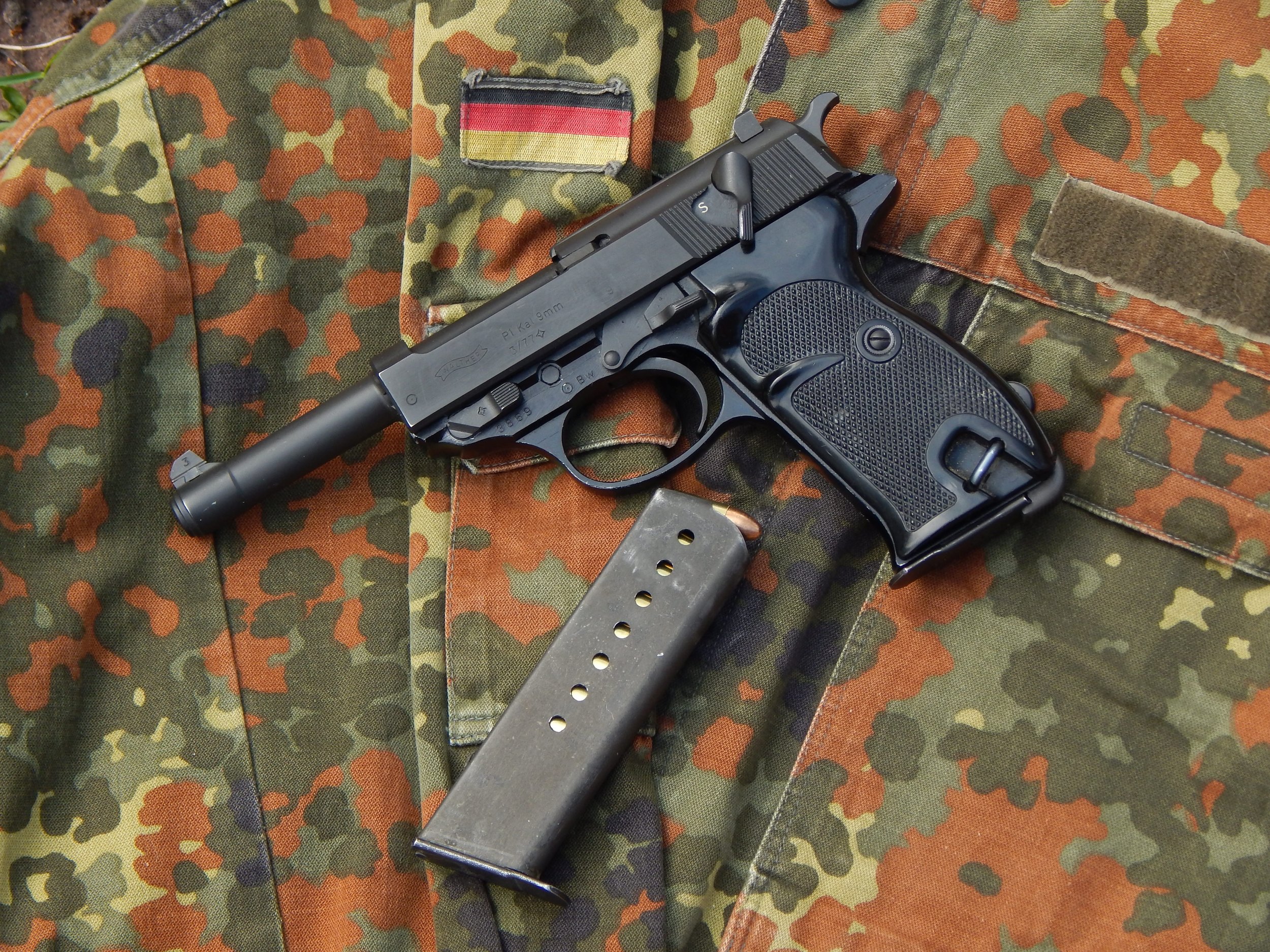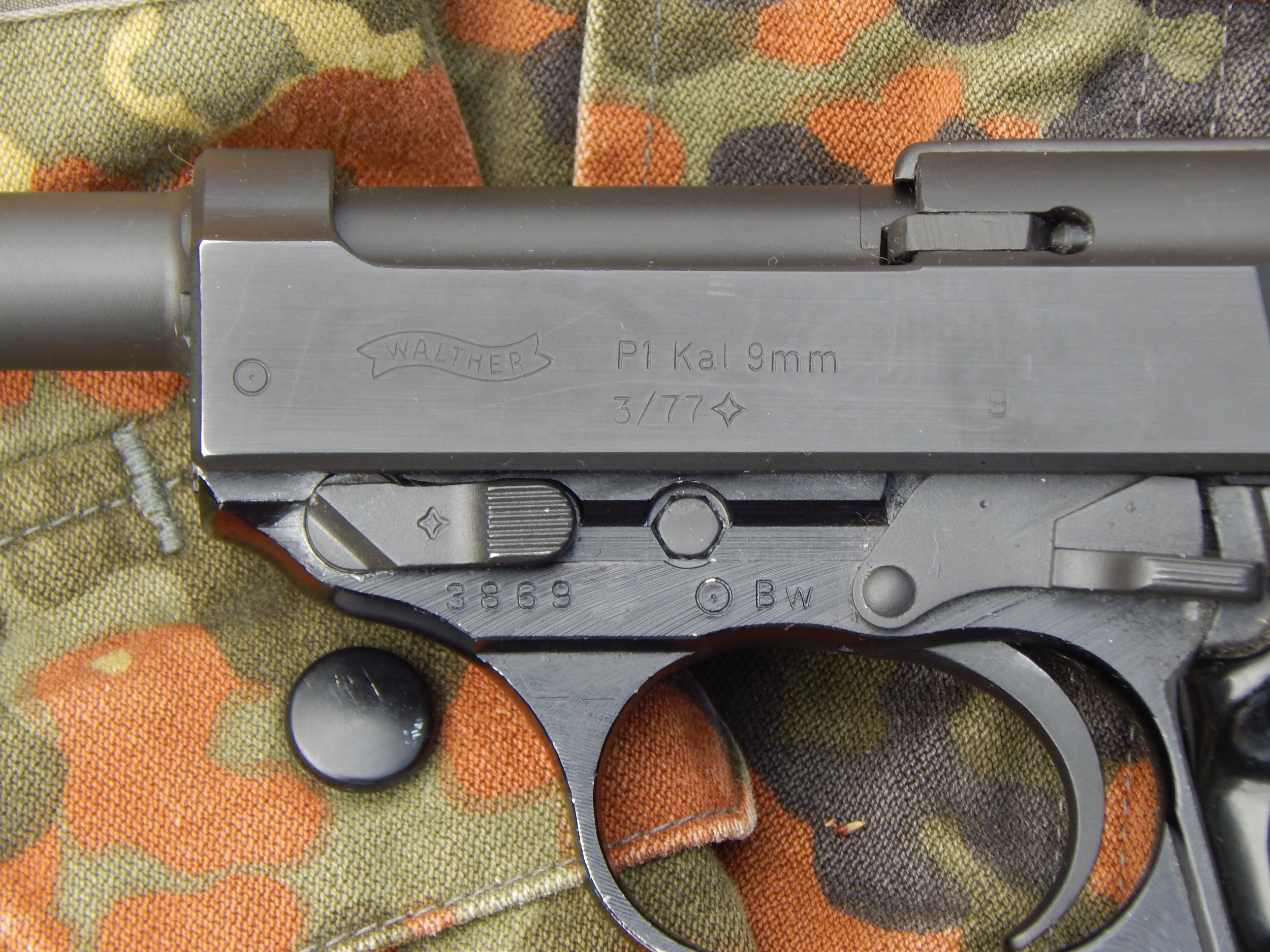Walther P1
In the aftermath of the Second World War Germany found itself divided. As it raised its own army to fight alongside NATO, the new West Germany looked to update the old wartime sidearm of the Wehrmacht.
The History
In the aftermath of the Second World War, the German nation found itself completely destroyed. Total warfare had consumed the country, leaving it stripped of basic resources and devastated by ferocious fighting. The once mighty German military, the Wehrmacht, was likewise in ruins, and it was not until 1955 that an independent German military would be raised, this time in the service of the West German Federal Republic. Known as the Bundeswehr (Federal Defense Forces), this force found itself in need of handguns as well as other equipment.
The sights of the P1 are larger and more squared than those on the earlier P38, and feature two white marks for low light use. Also note the loaded chamber indicator pin above the hammer, and the decocking safety on the slide
The standard service pistol of the old Wehrmacht had been the Walther P38, an excellent design in 9x19mm that could well be argued as the best all around design of the Second World War. Walter’s factor in Zella-Mellis had fallen into the Soviet Occupation Zone, although production of the firm’s designs had actually continued for the French at Manurhin, with tooling taken as war reparations. The company’s owner, Fritz Walther, had escaped to the west, and set up a new operation in Ulm, resuming production in 1949, the same year that the independent West German government was founded.
The new Walther was immediately investigated by the new Bundeswehr as a potential source of new handguns, with that body having selected the P38 as their standard issue. Deliveries of new pistols began in 1957, but a series of changes would culminate in a change of designation in 1963, with the new P1 being most obviously distinguished by their aluminum frames. A hexagonal bolt was later added to the frame as well starting in 1970, intended to prevent cracking. The P1 also featured a slightly thicker frame, as well as a redesigned firing pin, intended to solve the breakage issues that occurred in wartime P38s.
The slide of the P1 features the commercial Walther banner, the BRD having dispensed with the wartime codes. Also visible is this weapon’s manufacture date and the “Bw” marking indicating issue to the Bundeswehr
The P1 would equip not just the three branches of the Bundeswehr, but also the West German police and Grenzschutzen (border guards) for the duration of the Cold War, and would remain the basic sidearm of unified Germany until 2004, when it was replaced by the H&K P8. Another interesting variation of the P1 was assembled in France with German made parts in order to arm the West Berlin Police, as they were required by treaty to not carry German made arms. P1 pistols, often equipped with special white leather holsters, remain in service with the German ceremonial Wachtbattalion.
The right side of the slide features two West German eagle proof marks
The Design
At its core, the P1 remains the same as its wartime progenitor. The differences lie mainly in its aluminum slide, which does greatly reduce the weight of the weapon. This frame also often features the aforementioned hexagonal reinforcing lug forward of the trigger guard, and has a distinctive, mirrored black finish which contrasts with the grey parkerized finish of the steel slide and barrel. The grips on the P1 are another distinctive difference from the wartime pistols, replacing the latter’s distinctive ribbed bakelite grips with checkered black plastic (similar to that seen on the prototype P38 models).
Although the frame is now of aluminum alloy, the characteristic dual recoil springs of the P38 remain a hallmark
Internally, the P1 retains the distinctive dual recoil springs at the rear of the slide from the P38, as well as its double action trigger mechanism (the first seen in a production full size military handgun). The safety is located on the left hand side of the slide, and incorporates a decocker. The P1 also retains the loaded chamber indicator pin, which protrudes from the slide above the hammer, as well as the open topped slide, with its firing pin covered by a separate sheet steel plate held on by pring tension from arms on the underside.
The pistol chambers the 9x19mm cartridge, feeding from an eight round detachable magazine retained by a heel catch. The sights of the pistol are a notable difference from the P38 as well, being larger and squared off, with two white dots to aid in low light aiming. Internally, the P38’s locking block system is also retained, a system that would later go on the be used in the Beretta M92 series.
The barrel, when removed from the pistol, demonstrates the locking block mechanism of the P38 family, which would go on to influence future designs
This Example
The example here was borrowed from the author’s father, and was manufactured by Walther in Ulm in March of 1977. It is marked for use by the Bundeswehr, as evidenced by the “Bw” stamping on its frame, and has matching serial numbers on all components. Notably, this was the first full power handgun the author experienced, early in his tenure as a collector and arms history enthusiast.
The P1 (top) can be seen here compared to a 1945 production P38 pistol, and its differences in finish as well as features such as grips are apparent
Opinions
The P1 is, like the P38, and excellent handgun. Retaining many of the features that made the original great, and incorporating lighter weight as well as better low light sights and improved grips, the P1 makes for a defensive weapon even today. In the personal opinion of the author, the slimmer sights of the P38 are superior, although this is a minor complaint. Also of note is that while both pistols use a heel catch magazine release, the author feels that the design used here is probably the best such mechanism he has encountered.
A West German soldier poses with his hand on a holstered P1
Observed Values and Frequency
Updated: February, 2024
AVERAGE VALUE (USD): $500
FREQUENCY: Surplus
COLLECTOR’S NOTES: Early and commercial variants retaining the “P38” nomenclature exist.
Currently available on the surplus market








